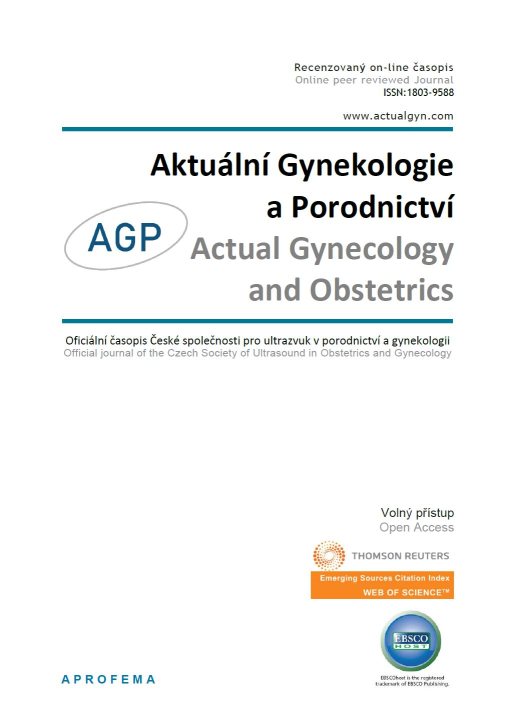Prevention, diagnosis and treatment of toxoplasmosis during pregnancy (article in Czech)
Review article
Abstract
Toxoplasmosis is one of the most common zoonoses in the Czech Republic. Toxoplasma infection during pregnancy can affect fetal development and cause multiple damages that often do not manifest until after the birth. The severity of pediatric disability, its variability and the probability of occurrence depend on the time of maternal infection. Serological diagnosis of toxoplasmosis in pregnant women is performed in two steps: first, total anti-Toxoplasma antibodies are detected, most commonly by the complement fixation test (CFT) combined with IgG ELISA. In the case of a negative result, the woman can be retested 1-3 months later. Low CFT titers show latent infection with a minimal risk of primary infection during pregnancy. When CFT titers of 1:64 or higher are obtained, the second step follows. Positivity in the IgM and IgA tests and low IgG avidity can confirm a recent infection. The diagnosis of fetal infection is based on the detection of anti-Toxoplasma antibodies, and of IgM antibodies in particular, and/or on the detection of Toxoplasma in amniotic fluid by PCR or the mouse test. Other helpful methods are fetal ultrasound or MRI focusing on fetopathy. Each child born from a high-risk pregnancy is thoroughly examined and followed up on a long-term basis. The detection of neonatal anti-Toxoplasma IgM antibodies and a neonatal IgG profile differing from the maternal IgG profile in comparative Western blot are the major markers of congenital infection. Toxoplasma infection can be treated prenatally and postnatally and the therapeutic outcomes are still being considered.
The first-line options for congenital toxoplasmosis are spiramycin, pyrimethamine and sulfadiazine with folinic acid. The article discusses the indications for screening and recommends best practices for the diagnosis, treatment and prevention of toxoplasmosis during pregnancy. It also addresses in detail the interpretation of the diagnostic results and provides guidance for preventive screening of pregnant women in the Czech Republic.
Key words: congenital toxoplasmosis, diagnosis of toxoplasmosis during pregnancy, interpretation of results, prenatal and postnatal treatment of toxoplasmosis, prevention of toxoplasmosis during pregnancy
Přehledový článek
Abstrakt
Toxoplasmóza je jedna z nejčastějších zoonóz u nás. Patří mezi onemocnění, která mohou při primoinfekci v graviditě ohrozit vývoj plodu či způsobit mnohočetná poškození, často manifestovaná až po narození dítěte. Závažnost postižení, jeho variabilita a pravděpodobnost vzniku závisí na době, kdy se těhotná žena nakazila. V ČR máme k dispozici několik diagnostických metod. Základem je sérologické vyšetření (protilátky celkové i jednotlivých tříd, avidita IgG, komparativní imunoblot), prováděné z krve či plodové vody. Možný je i přímý průkaz DNA Toxoplasma gondii pomocí PCR z krve, plodové vody či po porodu z placenty. Prenatálně se provádí izolační pokus na myši (inokulací plodové vody). Pomocnou metodou je také ultrazvuk či MRI v průběhu těhotenství, se zaměřením na případnou fetopatii. Po narození je dítě z rizikové gravdity podrobně vyšetřeno a dlouhodobě sledováno. Terapii lze podat prenatálně i postnatálně, o jejím efektu se vedou diskuse. Základními preparáty jsou spiramycin, pyrimethamin a sulfadiazin (doplněny kyselinou folinovou). V článku jsou probrány indikace k jednotlivým vyšetřením a doporučeny nejvhodnější postupy v diagnostice, léčbě a také prevenci tohoto onemocnění u těhotných. Text se podrobně věnuje i interpretaci možných výsledků a obsahuje vyjádření k preventivnímu vyšetření těhotných žen u nás.
Klíčová slova: kongenitální toxoplasmóza, diagnostika toxoplasmózy v těhotenství, interpretace výsledků, prenatální a postnatální terapie toxoplasmózy, prevence toxoplasmózy v graviditě












 Official publication of the Czech Society of Ultrasound in Obstetrics and Gynecology.
Official publication of the Czech Society of Ultrasound in Obstetrics and Gynecology.
